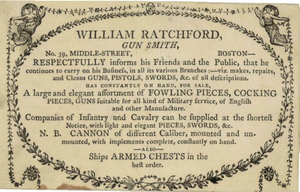Gunsmith

Agunsmithis someone who makes and ordesignsguns.[1]The job of a gunsmith is similar, but not the same as anarmorer.[2]Theoriginof the word gunsmith dates back to the 1580s.[3]
History
[change|change source]The first firearms can be dated to about the 1200s inChina.[4]In Europe, the first gun barrels were made by pItaliancraftsmen.But gunsmithing was new in the Middle Ages. For a long time they did not have their ownguildsand many joinedblacksmiths’ guilds.[4]By the mid-1400s, there were enough gunsmiths to form their own guilds. One of the first was in 1463 inSuhl, Germany.[4]England did not develop gunsmiths as quickly as other European countries and to change this,KingHenry VIIIinvited leading gunsmiths in Europe to come live and work in England.[4]Many accepted and not long afterwards more gun shops began appearing in England. Several appeared inLondonnear theTower of London,which held the country'sstockpileof guns.[4]Soon they were training Englishcitizensin this new trade.[4]

Before theAmerican Revolutionary Warin theAmerican colonies,gunsmithing was atime-consumingprocess.[5]Gunsmiths were generally gun makers who repaired their own weapons for theircustomers.[5]These gunmakers came to the American colonies along with other craftsmen fromEngland,and later fromGermanyandSwitzerland.These were countries with long histories of gun making. Gunsmiths learned their trade by becoming anapprenticeto an established gunsmith or gun maker.[5]They worked from theiradolescenceinto earlyadulthoodbefore they could open ashopof their own.[5]Handgunswere relatively cheap and were made in large shops in England.[5]So American gunsmiths repaired and modifiedimportedpistols. However,musketsandrifleswere not imported as much and local gunsmiths would custom make these for their customers.[5]Their work includedcarvingstocks,engravingmetalpieces, andforginggun barrels.[5]It could take as many as 400 hours to create guns by hand.[5]Soon entirely new guns were created such as thePennsylvania rifle(later called the "Kentucky rifle" ).[6]This was the product ofGermangunsmiths whoimmigratedtoPennsylvaniain the early18th century.It was lighter, longer and moreaccuratethan European designs. The rifle soon became the favorite of colonialsettlersandFrontiersmen.[7]
About the middle of the18th century,gunsmithHonoré Blancdeveloped the concept ofinterchangeable partsfor muskets.[8]Blanc tried to interest other European gunsmiths, but they were not impressed by the idea. But he did interest the AmericanAmbassadortoFrance,Thomas Jefferson.Jefferson quickly saw thatmass productionof weapons parts would free America from dependence on European sources for parts. He could not get Blanc to move to the United States but he did convincePresidentGeorge Washingtonit was a good idea. In 1798,Eli Whitneygot the firstcontractfor 12,000 muskets built under the new system.[8]Whitney used a large force of unskilled workers and machinery to produce standardized identical parts at a low cost.[9]This was about the time Gun manufacturers began to be distinguished from gunsmiths.
Gunsmithing schools
[change|change source]Long a part ofAmerican historyandculture,gunsmithing is anoccupationwith a long history.[10]Today, the way to become a gunsmith is to attend a gunsmithingschoolor take gunsmithingclasses.[11]There are several gunsmithing schools in theUSand alsoonline schools.
Accredited traditional schools
[change|change source]The following schools areaccreditedby theNational Rifle Association of America:
- Montgomery Community College,Troy, North Carolina.[12]
- Trinidad State Junior College,Trinidad, Colorado.[12]
- Murray State College,Tishomingo, Oklahoma.[12]
- Lassen Community College,Susanville, California.[12]
Additional schools include:
- Yavapai College,Prescott, Arizona.[13]
- Piedmont Technical College,Greenwood, South Carolina.[13]
- Colorado School of Trades,Lakewood, Colorado.[13]
- Lenoir Community College,Kinston, North Carolina.[13]
- Pine Technical College,Pine City, Minnesota.[13]
Accredited online schools
[change|change source]- Ashworth College,offers adiplomain gunsmithing.[11]Their webpage ishttps://www.ashworthcollege.edu/.
- Penn Foster Career Schooloffers a gunsmithing program.[11]Their web page is:http://www.pennfoster.edu/enrolltoday/index.html
Other countries
[change|change source]In theUnited Kingdom,there are gunsmithing schools. Another path to becoming a gunsmith is through apprenticeship.[14]At times, larger gun makers or repairers may take on someone to learn the trade.[14]These positions are not usuallyadvertisedand are often discovered byword of mouthor through friends or family. Smaller gunmakers and gunsmiths cannot usually afford to take on an apprentice.[14]
References
[change|change source]- ↑"Definition of GUNSMITH".Definition of Gunsmith by Merriam-Webster.25 January 1928.Retrieved30 July2016.
- ↑"Gunsmith".TheFreeDictionary.com.Retrieved2016-07-30.
- ↑"the definition of gunsmith".Dictionary.com.Retrieved2016-07-30.
- ↑4.04.14.24.34.44.5"The History of Gunsmithing".Colorado School of Trades.Retrieved31 July2016.
- ↑5.05.15.25.35.45.55.65.7"History of Gunsmithing in Early America".SR Education Group.Retrieved31 July2016.
- ↑Guns in American Society: An Encyclopedia of History, Politics, Culture, and the Law,Volume 1, ed. Gregg Lee Carter (Santa Barbara, CA: ABC-CLIO, 2012), p. 523
- ↑"Kentucky Long Rifle".FrontierFolk.org.Retrieved31 July2016.
- ↑8.08.1George Mouradian,The Quality Revolution(Lanham, MD: University Press of America, 2002), p. 83
- ↑"The evolution of assembly lines: A brief history".Robohub Digest.Retrieved31 July2016.
- ↑"The Art of Gunsmithing".National Rifle Association of America.Retrieved31 July2016.
- ↑11.011.111.2"Complete Guide to Online Gunsmithing Schools".OnlineU.Retrieved31 July2016.
- ↑12.012.112.212.3"NRA Gunsmithing Schools".National Rifle Association of America.Retrieved31 July2016.
- ↑13.013.113.213.313.4"List of the Top Gunsmithing Schools in the U.S."Study.com.Retrieved31 July2016.
- ↑14.014.114.2"How to become a gunsmith".Greenwood Gunsmiths. Archived fromthe originalon 4 May 2016.Retrieved31 July2016.
